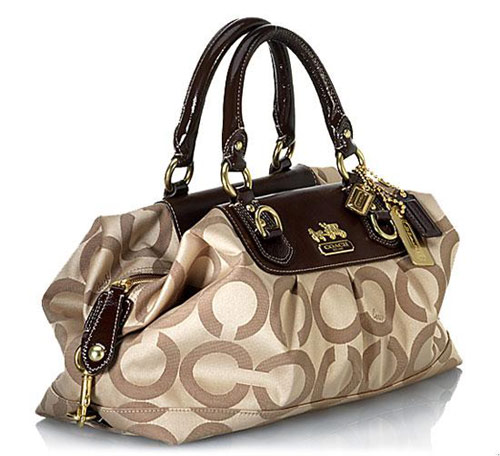
|
Coach, the maker of luxury handbags and other sundry accessories, has been having a rough year. Poor sales prompted a leadership shuffle in July, and after a particularly bad earnings report Tuesday, the stock took its biggest dive in years. Which is odd, because the luxury market has been doing really well overall, fed by a global elite with assets that seem to have fully recovered from the recessionary dumps. So what's the problem?
"If you're a luxury brand with outlet stores, maybe you're not a luxury brand," mused Tim Hanson of Motley Fool Funds on a podcast Tuesday. "They took a growth-at-any-costs attitude that has done brand damage that they are paying for, but at the time that they were doing [it], it fielded stock price gains because it allowed them to put up very heady revenue numbers." It's a problem all luxury brands face, especially public ones: How can you both sell enough on a quarterly basis to make Wall Street happy while at the same time maintaining the aura of exclusivity that got you where you were in the first place? Mark Cohen, a professor of retail at the Columbia University Business School, ticks off the companies that have fallen into the ubiquity trap. Bill Blass "never met a licensee he didn't do a deal with," he says. Neiman Marcus "has opened stores in the last seven, eight years that they wish they could take back." Saks Fifth Avenue "took developer deals 25 years ago that gave them the immediate appearance of growth, which was false." Martha Stewart, Ralph Lauren, and Barney's haven't done themselves any favors either by going mass market either. "It's the designer toilet seat problem," Cohen says. "The luxury business is entirely contingent on limited availability, limited supply, and limited exposure." In recent years, big luxury retailers have found a way around the problem by pivoting to Asia, leveraging their iconic status in places like Japan and China to achieve huge sales without tarnishing their image at home. Coach hasn't had as much success there, perhaps because it doesn't have the same kind of world-wide super-appeal of a Prada or Gucci. Hermes and Tiffany's are typically seen as the gold standard in maintaining brand purity -- compensating for small sales volume with really, really high margins. Privately-held Godiva has managed to operate on two tracks, selling pricey chocolates both in convenience stores and its own, super-luxe retail spaces. Coach is also at a disadvantage because it's not part of a large umbrella corporation that can compensate for slow growth in one of its portfolio companies with fast growth in another. A lot of the luxury marketplace falls into a few big spheres of influence: LVMH owns Hennessy, Louis Vuitton, Veuve Clicquot, Dom Perignon, Givenchy, Marc Jacobs, Fendi, Christian Dior, Belvedere, Thomas Pink, Donna Karan, Sephora, and many more. Richemont owns Montblanc, Cartier, Piaget, and Van Cleef & Arpels. Kering owns Gucci, Balenciaga, Alexander McQueen, Stella McCartney, etc. Because they're diversified, they can invest in new designers, much like a big record label can -- or could, in better days -- take chances on minor artists on the off chance they take off.
If Coach is to recover, Wall Street is going to need to let it ease off the gas pedal, make like Burberry, and realize that a sterling brand and massive sales are a contradiction in terms. |
蔻驰(Coach)是世界著名奢侈品品牌,主营男女精品配饰,尤以手袋闻名,但今年业绩欠佳。7月,因销量惨淡,蔻驰高层发生了变动,再加上本周二,蔻驰公布了令人失望的收益报告,双重打击之下,蔻驰股票大跌,跌幅创历史新高。然而,在富有的精英阶层似乎完全从经济危机中恢复过来,并带动整个奢侈品消费市场走向繁荣之时,蔻驰糟糕的销售业绩实在令人觉得费解。那么,蔻驰究竟出了什么问题? 攻势猛烈的新兴品牌自然是挑战之一,如凯特·思蓓(Kate Spade)和迈克·科尔斯(Michael Kors),这些品牌更得年轻消费者青睐。他们认为蔻驰是富有阿姨辈的专属,打个比方说,新兴品牌就像是纽约年轻时尚的教会区(Mission District),而蔻驰则像是第五大道(5th Avenue),更为奢侈古板。 但更大的问题可能来自于产品初期的过速发展。投资者急于追求利润的增长,蔻驰因此不得不在过去的几年间不断扩大生产规模并增开几十家工厂直销店,这样做的确使其利润有了飞跃,但这时蔻驰已不再是原来的蔻驰。 蒂姆·汉森是美国著名投资论坛“彩衣傻瓜”(Motley Fool Funds)的全球收益顾问,本周二,他在自己的播客中沉思自问:“一个奢侈品牌如果有了工厂店,那还能叫奢侈品吗?为了追求利润而不择手段,品牌形象会受损,他们将自食恶果,但收益表上的数字确实让人飘飘然,也带动了股价增长。” 不仅是蔻驰,全球所有奢侈品牌,尤其是公众品牌,都在面临这样一个问题:如何在保持一个令华尔街满意的季度销量的同时维持产品独有的格调而不违背其品牌初衷。 哥伦比亚大学商学院零售学教授马克·科恩列举了几个陷入“普遍性陷阱”的公司实例。比如比尔·布拉斯(Bill Blass),它从来不会拒绝任何一个授权方的交易请求;尼曼(Neiman Marcus)在过去的七八年间开了好几家分店,而现在他们却后悔了;萨克斯第五大道精品百货店(Saks Fifth Avenue)25年前接受了开发商的协议,并因此带来了繁荣的假象;玛莎·司徒沃特(Marsha Stewart),拉尔夫·劳伦(Ralph Lauren)和巴尼斯纽约精品店(Barney's)此类品牌也未从扩大的市场中获得任何优势。 科恩说:“这关乎设计上的供求问题,奢侈品需要做到供不应求,要知道这个行业完全是依靠限量生产、限量供应和限量发行来运作的。” 近年来,一些奢侈品零售巨头找到了两全其美的办法,即以亚洲为销售重心,利用自身“品牌效应”在中国、日本等国取得巨额销量,而丝毫不影响在国内的形象。但是蔻驰没有像普拉达(Prada)和古奇(Gucci)那样的国际产品知名度,所以并未在亚洲市场上取得多大的成功。爱马仕(Hermes)和蒂凡尼(Tiffany)则是业内严守产品高贵血统这一黄金准则的楷模,它们用高利润来填补销量的不足。私人企业歌蒂凡(Godiva)则采用了两种营销模式:将公司生产的昂贵巧克力同时在便利店和自己的奢侈专卖店中出售。 蔻驰的另一个劣势在于它不隶属于任何一个大公司,因此也不存在销售业绩较好与较差的投资组合公司之间的互补。许多奢侈品公司旗下都有多个颇具影响力的品牌,如法国酩悦·轩尼诗-路易·威登集团(LVMH),该公司旗下拥有如下品牌:轩尼诗(Hennessy)、路易·威登(Louis Vuitton)、凯歌香槟(VeuveClicquot)、唐培里侬香槟(Dom Perignon)、纪梵希(Givenchy)、马克·雅各布(Marc Jacobs)、芬迪(Fendi)、克里斯汀·迪奥(Christian Dior)、雪树伏特加(Belvedere)、托马斯·品客(Thomas Pink)、唐纳·卡兰(Donna Karan)、丝芙兰(Sephora)等等;历峰集团(Richemont)旗下拥有:万宝龙(Montblanc)、卡地亚(Cartier)、伯爵表(Piaget)以及梵克雅宝(Van Cleef&Arpels);开云集团(Kering)所属品牌有:古奇(Gucci)、巴黎世家(Balenciaga)、亚历山大·麦昆(Alexander McQueen)、斯特拉·麦卡特尼(Stella McCartney)等。就像规模较大的唱片公司现在或景况好时,会在二流艺术家身上试试运气,即使成功的希望渺茫。 奢侈品顾问凯蒂·梅森卢兹称:“投资者从投入资金到收回成本大概需要5到7年的时间。你看那些现在很成功的品牌,他们中大部分都试图找到规律,来确保自身发展速度不过快。” 蔻驰要想重振旗鼓,华尔街就应该适当放手,效仿巴宝莉(Burberry)的做法,并意识到品牌的高贵形象与巨大的销量是不可兼得的。 (译者 YulisaLu 编辑 丹妮) |
